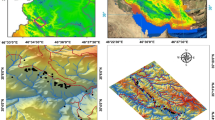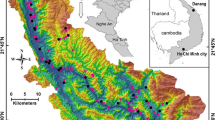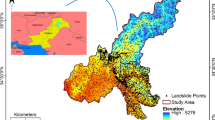Abstract
Regional Landslide Susceptibility Zonation (LSZ) is always challenged by the available amount of field data, especially in southwestern China where large mountainous areas and limited field information coincide. Statistical learning algorithms are believed to be superior to traditional statistical algorithms for their data adaptability. The aim of the paper is to evaluate how statistical learning algorithms perform on regional LSZ with limited field data. The focus is on three statistical learning algorithms, Logistic Regression (LR), Artificial Neural Networks (ANN) and Support Vector Machine (SVM). Hanzhong city, a landslide prone area in southwestern China is taken as a study case. Nine environmental factors are selected as inputs. The accuracies of the resulting LSZ maps are evaluated through landslide density analysis (LDA), receiver operating characteristic (ROC) curves and Kappa index statistics. The dependence of the algorithm on the size of field samples is examined by varying the sizes of the training set. The SVM has proven to be the most accurate and the most stable algorithm at small training set sizes and on all known landslide sizes. The accuracy of SVM shows a steadily increasing trend and reaches a high level at a small size of the training set, while accuracies of LR and ANN algorithms show distinct fluctuations. The geomorphological interpretations confirm the strength of SVM on all landslide sizes. Our results show that the strengths of SVM in generalization capability and model robustness make it an appropriate and efficient tool for regional LSZ with limited landslide field samples.
Similar content being viewed by others
References
Abdallah C, Chorowicz J, Bou Kheir R, et al. (2005) Detecting major terrain parameters relating to mass movements’ occurrence using GIS, remote sensing and statistical correlations, case study Lebanon. Remote Sensing of Environment 99: 448–461.
Aleotti P, Chowdhurry R (1999) Landslide hazard assessment: summary review and new perspectives. Bulletin of Engineering Geology and the Environment 58: 21–44.
Anbalagan R (1992) Landslide susceptibility evaluation and zonation mapping in mountainous terrain. Engineering Geology 32: 269–277.
Bai S, Wang J, Lv G, et al. (2007) GIS-based and data drive bivariate landslide susceptibility mapping in the Three Gorge Area, China. Journal of Mountain Science 25(1): 85–92. (In Chinese).
Bai SB, Wang J, Lü G-N, et al. (2010) GIS-based logistic regression for landslide susceptibility mapping of the Zhongxian segment in the Three Gorges area, China. Geomorphology 115: 23–31.
Balabin RM and Lomakina EI (2011) Support vector machine regression (SVR/LS-SVM)-an alternative to neural networks (ANN) for analytical chemistry? Comparison of nonlinear methods on near infrared (NIR) spectroscopy data. Analyst 136: 1703–1712.
Bălteanu D, Chendes V, Sima M, et al. (2010) A country-wide spatial assessment of landslide susceptibility in Romania (in press). Geomorphology.
Basheer IA, Hajmeer M (2000) Artificial neural networks: fundamentals, computing, design and application. Journal of Microbiological Methods 43: 3–31.
Bishop CM (1995). Neural Networks for Pattern Recognition. Oxford University Press, Oxford, UK.
Brabb EE, Pampeyan EH, Bonilla M (1972) Landslide susceptibility in the San Mateo County, California, scale 1:62,500. USGS Miscellaneous Field Studies Map, MF344.
Brenning A, Trombotto D (2006) Logistic regression modeling of rock glacier and glacier distribution: topographic and climatic controls in the semi-arid Andes. Geomorphology 81: 141–154.
Bui DT, Pradhan B, Lofman O, et al. (2012) Landslide susceptibility assessment in Vietnam using suport vector machines, decision tree, and naïve bayes models. Mathematical problems in Engineering: 1–26.
Carrara A, Cardinali M, Detti R, et al. (1991) GIS techniques and statistical models in evaluating landslide hazard. Earth Surface Processes and Landforms 16: 427–445.
Cascini L (2008) Applicability of landslide susceptibility and hazard zoning at different scales. Engineering Geology 102: 164–177.
Chang CC, Lin CJ (2011) LIBSVM: a library for support vector machines. ACM transactions on Intelligent Systems and Technology 2(27): 1–27.
Chauhan S, Sharma M, Arora MK, et al. (2010) Landslide susceptibility zonation through ratings derived from Artificial Neural Network. International Journal of Applied Earth Observation and Geoinformation 12: 340–350.
Chong X, Dai FC, Xu XW, et al. (2012) GIS-based support vector machine modelling of earthquake-triggered landslide suscpetibility in the Jianjiang River watershed, China. Geomorphology 145: 70–80.
Clerici A, Perego S, Tellini C, et al. (2002) A procedure for landslide susceptibility zonation by the conditional analysis method. Geomorphology 48: 349–364.
Congalton RG (1991) A review of assessing the accuracy of classifications of remotely sensed data. Remote Sensing of Environment 37: 35–46.
Dai FC, Lee CF, Nagi Y (2002) Landslide risk assessment and management: an overview. Engineering Geology 64: 65–87.
DeGraff J, Romesburg H (1980) Regional landslide-susceptibility assessment for wildland management: a matrix approach. In: Coates D, Vitek J (Eds.) Thresholds in geomorphology. George Allen and Unwin, London, UK. pp 401–414.
DLR (Shaanxi) (2003) Atlas of geological hazard in Shaanxi Province (Hanzhong Fascicule). Department of Land and Resources of Shaanxi Province, Xi’an, China.
Ercanoglu M, Gokceoglu C, Van Asch TWJ (2004) Landslide susceptibility zoning north of Yenice (NW Turkey) by multivariate statistical techniques. Natural Hazards 32: 1–23.
Ermini L, Catani F, Casagli N (2005) Artificial neural networks applied to landslide susceptibility assessment. Geomorphology 66: 327–343.
Fell R, Corominas J, Bonnard C, et al. (2008) Guidlines for landslide susceptibility, hazard, risk zoning for land-use planning. Engineering Geology 102: 99–111.
Fieldings AH, Bell JF (1997) A review of methods for the assessment of prediction errors in the conservation presence/absence methods. Environmental Conservation 24(1): 38–49.
Frattini P, Crosta G, Carrara A (2010) Techniques for evaluating the performance of landslide susceptibility models. Engineering Geology 111: 62–72.
George D, Mallery P (2000). SPSS Windows Step by Step: A Simple Guide and Reference. Allyn and Bacon, New York, NY, USA.
Gong P (1996) Integrated analysis of spatial data for multiple sources: using evidential reasoning and artificial neural network techniques for geological mapping. Photogrammetric Engineering and Remote Sensing 62(5): 513–523.
Gupta RP, Kanungo DP, Arora MK et al. (2008) Approaches for comparative evaluation of raster GIS-based landslide susceptibility zonation maps. International Journal of Applied Earth Observation and Geoinformation (10): 330–341.
Haykin S (1998) Neural Networks: A Comprehensive Foundation. Prentice Hall, London, UK.
Holec J, Bednarik M, Sabo M, et al. (2013) A small-scale landslide susceptibility assessment for the territory of Western Carpathians. Natural Hazards 69(1): 1081–1107.
Jade S, Sarkar S (1993) Statistical models for slope instability classification. Engineering Geology 36: 91–98.
Kanungo DP, Arora MK, Starker S, et al. (2006) A comparative study of conventional, ANN black box, fuzzy and combined neural and fuzzy weighting procedures for landslide susceptibility zonation in Darjeeling Himalayas. Engineering Geology 85(3–4): 347–366.
Lan HX, Zhou CH, Wang LJ, et al. (2004) Landslide hazard spatial analysis and prediction using GIS in the Xiaojiang watershed, Yunnan, China. Engineering Geology 76: 109–128.
Lee S, Ryu J, Min K, et al. (2003) Landslide susceptibility analysis using GIS and artificial neural network. Earth Surface Processes and Landforms 28: 1361–1376.
Lillesand TM, Kiefer RW, Chipman JR (2008) Remote Sensing and Image Interpretation, Sixth Edition. John Wiley & Sons Inc., Beijing, China.
Liu MG, Ed. (1997) Atlas of Physical Geography in China. SinoMaps Press, Beijing, China.
Ma LF, Ed. (2002) Atlas of China Geology. Geology Publishing House, Beijing, China.
Marjanović M, Kovačević M, Bajat B, et al. (2011) Landslide susceptibility assessment using SVM machine learning algorithm. Engineering Geology 123: 225–234.
Micheletti N, Foresti L, Robert S, et al. (2013) Machine learning feature selection methods for landslide susceptibility mapping. Mathematical Geosciences 46: 33–57.
Monserud RA, Leemans R (1992) Comparing global vegetation maps with the Kappa statistics. Ecological Modelling 62: 275–293.
Nefeslioglu HA, Gokcegolu C, Sonmes H (2008) An assessment on the use of logistic regression and artificial neural networks with different sampling strategies for the preparation of landslide susceptibility maps. Engineering Geology 97: 171–191.
Pradhan B (2010) Remote sensing and GIS-based landslide hazard analysis and cross-validation using multivariate logistic regression model on three test areas in Malaysia. Advances in Space Research 45: 1244–1256.
Pradhan B (2013) A comparative study on the predictive ability of the decision tree, support vector machine and neuro-fuzzy models in landslide susceptibility mapping using GIS. Computers & Geosciences 51: 350–365.
Pradhan B, Lee S (2007) Utilization of optical remote sensing data and GIS tools for regional landslide hazard analysis using an artificial neural network model. Earth Science Frontiers 14(6): 143–152.
Pradhan B, Lee S (2010) Landslide susceptibility assessment and factor effect analysis: backpropagation artificial neural networks and their comparison with frequency ratio and bivariate logistic regression modelling. Environmental Modelling & Software 25: 747–759.
Pradhan B, Lee S, Buchroithner MF (2010) A GIS-based backpropagation neural network model and its cross-application and validation for landslide susceptibility analysis. Computers, Environment and Urban Systems (34): 216–235.
Rossi M, Guzzetti F, Reichenbach P, et al. (2010) Optimal landslide susceptibility zonation based on multiple forecasts. Geomorphology 114(3): 129–142.
Saha AK, Gupta RP, Starker I, et al. (2005) An approach for GIS based statistical landslide susceptibility zonation-with a case study in the Himalayas. Landslides 2: 61–69.
Samui P, Kothari DP (2010) Utilization of a least square support vector machine (LSSVM) for slope stability analysis. Scientia Iranica 18(1): 53–58.
Tax D, Duin E (1999) Support vector domain description. Pattern Recognition Letter 20: 1191–1199.
Vapnik VN (1995). The Nature of Statistical Learning Theory. Springer, New York, NY, USA.
Wang H, Liu G, Xu W, et al. (2005) GIS-based landslide hazard assessment: an overview. Progress in Physical Geography 29: 548–567.
Wang WD, Cui CM, Du XG (2009) Landslides susceptibility mapping in Guizhou province based on fuzzy theory. Mining Science and Technology (19): 399–404.
Yalcin A, ReiS S, Aydinoglu AC, et al. (2011) A GIS-based comparative study of frequency ratio, analytical hierarchy process, bivariate statistics and logistics regression methods for landslide susceptibility mapping in Trabzon, NE Turkey. Catena 85: 274–287.
Yao X, Tham LG, Dai FC (2008) Landslide susceptibility mapping based on Support Vector Machine: a case study on natural slopes for Hongkong, China. Geomorphology 101: 572–582.
Yesilnacara E, Topal T (2005) Landslide susceptibility mapping: A comparison of logistic regression and neural networks methods in a medium scale study, Hendek region (Turkey). Engineering Geology 79: 251–266.
Yilmaz I (2009) Landslide susceptibility mapping using frequency ratio, logistic regression, artificial neural networks and their comparison: A case study from Kat landslides (Tokat-Turkey). Computers & Geosciences 35: 1125–1138.
Yilmaz I (2010a) Comparison of landslide susceptibility mapping methodologies for Koyulhisar, Turkey: conditional probability, logistic regression, artificial neural networks, and support vector machine. Environmental Earth Sciences 61: 821–836.
Yilmaz I (2010b) The effect of the sampling strategies on the landslide susceptibility mapping by conditional probability and artificial neural networks, Environmental Earth Science 60(3): 505–519.
Yilmaz I, Keskin I (2009) GIS based statistical and physical approaches to landslide susceptibility mapping (Sebinkarahisar, Turkey). Bulletin of Engineering Geology and the Environment 68(4): 459–471.
Zhang WB, Jin SL, Eds. (1995). Atlas of China. SinoMaps Press, Beijing, China.
Author information
Authors and Affiliations
Corresponding author
Rights and permissions
About this article
Cite this article
Wang, Yt., Seijmonsbergen, A.C., Bouten, W. et al. Using statistical learning algorithms in regional landslide susceptibility zonation with limited landslide field data. J. Mt. Sci. 12, 268–288 (2015). https://doi.org/10.1007/s11629-014-3134-x
Received:
Accepted:
Published:
Issue Date:
DOI: https://doi.org/10.1007/s11629-014-3134-x




